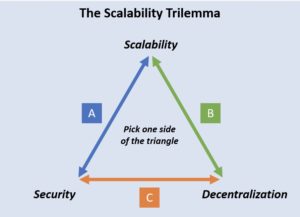2020 was the vision year upon which key takeaways in the blockchain industry would take shape. What are these takeaways?
For instance, in 2018, Toque Magazine reporter Marcel Gogan outlined seven predictions for the blockchain industry by the year 2020. I observed three significant projections in that list that reflect the far and much blockchain has achieved.
The integration of the rule of law into smart contracts has given birth to the democratization of the internet. The main idea behind smart contracts was for internet parties to comply with a set of terms and conditions. In the wake of solving contractual disputes between buyers and sellers, this concept is revolutionizing decentralized justice. The concept is being practically applied in projects such as Kleros.io.
The second takeaway was that economy and finance would lead to the next development phase of blockchain.
Cryptocurrencies are already reducing friction in cross border transactions and remittance. Projects such as Ripple are streamlining the path towards institutional adoption of blockchain. Remember Moneygram’s partnership with Ripple. The face of 2020 presents a shift of traditional banking concepts to iteration with blockchain to reduce excess bureaucracy, conduct faster transactions, and improve privacy. Banks will derive a lot of value neighbouring a billion figures by implementing blockchains.

Gogan’s third key prediction was the appearance of national cryptocurrency by the year 2020. Governments were a bit skeptical about the first appearance of cryptocurrencies. A situation characteristic of several central bank bans and restrictions. China is in the final stages of launching its digital renminbi, while Venezuela is hopeful that it could bypass sanctions using digital coins. Additionally, the United States is drafting plans for a digital dollar.
Despite the blockchain being over a decade old, operational problems have been persistent. The world has warmed up to create practical solutions using decentralization. Technologists anticipate bolstering scalability, speed, interoperability, cost, decentralization, and centralization of private/public chains.
The working mission for blockchain technology is to create a solution for every problem. While the genesis of blockchain technology has been to find practical applications, the turning point would be enhanced operation. Companies need to leverage technology in a way that deploys their services effectively.
Since all seven takeaways of Marcel Gogan’s predictions have come to pass, the next phase for the year is open doors for firms to become decentralized.
It’s been noted that the hindering factors to the adoption of blockchain are scalability and interoperability. Developers are building cutting edge blockchain solutions that are isolated, incompatible, and siloed. Take, for instance, the popular Hyperledger, which at least 25 businesses on the Forbes blockchain 50 list are using. In case the other fifty wanted to link to the solutions of the other half, what portability factor would even guarantee such interoperability?
Cross blockchain pilots are likely to take over the blockchain in 2020. Interoperability has opened up a platform for researching how digital assets and virtual chains can co-exist.
On the other hand, are scalability issues. Libra outlined in its whitepaper that there exists no scalable solution for its billion global users. This, therefore, shows how critical the issue of scalability is. Bitcoin’s lightning network processes seven transactions per second. Ethereum is slightly higher with 15, and then comes the fastest blockchain, Ripple, with 1500 transactions per second. Meanwhile, Visa processes 2,400 transactions per second on average. These speeds represent a potential bottleneck for adoption.

Visa handles at least 150 million transactions a day. For blockchain to beat the competition of that size, there has to be a rimmed down hash complexity. Blockchain developers can achieve this complexity by either reducing block time or increasing the block size. Any of both methods create a throughput that only hits the ceiling before reaching Visa level transaction speeds. Let’s unpack these problems from an arithmetic formula on the Bitcoin blockchain.
The average block size is one megabyte (1,048,576 bytes). Theoretically, the block size could scale to four megabytes through Segregated Witness (SegWit). SegWit defines a soft fork change on the format of a bitcoin transaction. Ideally, the average transaction size is 380.04 bytes on the assumption that each transaction comes from wallet X.
To calculate the average amount of transactions that could fit within one bitcoin block, let’s do this:

The generation time for every bitcoin block is 10 minutes. That means that the blockchain will generate a new blockchain at the end of every ten minutes. Ten minutes are equivalent to 600 seconds. Since the average block time transactions are 2,759.12 transactions, the ordinary transactions per second are, therefore, 4.6.
Based on the equation above, only two variables will directly affect the rate of transactions per second — the block size and the block generation time. Increasing the block size will instantly increase the speed of transactions but second. Unfortunately, Satoshi Nakamoto hardcoded the block size to one megabyte. Decreasing block time will increase the rate of transactions per second, and this is only possible by adjusting the complexity of the hashing puzzle (the algorithm for solving the proof of work).
There are three scenarios for competing with Visa. Bitcoin’s blockchain multiplying its current rate of transactions per second by 377.5. Which also means adjusting the block size from one megabyte to 377.5 megabytes.
The second would be reducing the block time from 10 minutes to 1.6 seconds. Adjusting both also serves as a possible scenario to boost network speeds. Unfortunately, the lot of two is made impossible by a second factor; both of the first two scenarios are dependant on the relay time for broadcasting a new block to each node of the blockchain.
There are over 10,000 nodes on the bitcoin network. The time for propagating at least one megabyte to each node is quite unimaginable.
Note that the average propagation time for each node is around 13 seconds as of 2019. This time propagates 99% of the entire network. When block time falls below relay time, a new block is generated before all network blocks receive the old one. As the block time gets closer to 99%, the more issues arise on double-spending attacks, security vulnerabilities, chain re-organizations, and orphan blocks.
This is only one scenario of numerous exploited possibilities that haven’t worked.
Ethereum Founder Vitalik Buterin describes these host of challenges as the scalability trilemma. To fully exploit the potentials of decentralization, you could only have one of either scalability or security.

Hopefully, 2020 is the year that blockchains will able to solve the areas of scalability and interoperability.

